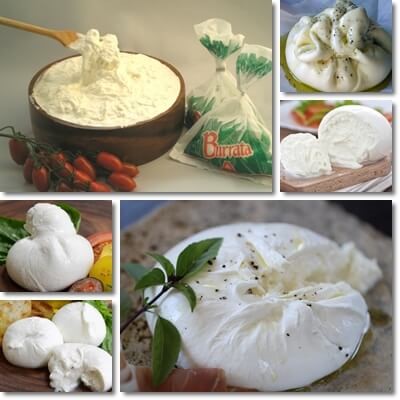What is burrata? Burrata is a semi-soft, fresh cheese of Italian origin. The term ‘burrata’ means ‘buttered’ in Italian and describes a variety of the cheese filled with butter or butter and sugar instead of the usual mozzarella shreds and cream. Burrata is a highly prized artisanal cheese dating back to the beginning of the 20th century and is made from a pouch of fresh mozzarella typically filled with fresh mozzarella shreds (called stracciatella) and cream.
In some cases, the mozzarella pouch is filled with butter or butter and sugar, but this is more unusual these days. The burrata is then tied with asphodel leaves both for presentation purposes and as an indicator of freshness; if the asphodel leaves are wilted upon serving, it means the cheese is no longer fresh.
How to make burrata cheese
For the original burrata recipe, fresh mozzarella cheese is prepared from fresh pasteurized or unpasteurized Italian Mediterranean buffalo milk (water buffalo milk). In order to make the original burrata cheese, only Italian Mediterranean buffalo milk may be used. And the mozzarella made from it will bear a special name designating the type of milk used – Mozzarella di bufala.
The mozzarella used for burrata cheese is called ‘pasta filata’ (meaning spun paste, stretched curd, pulled curd, plastic curd). It’s prepared using a traditional technique that involves steeping fresh curd in hot water or whey for several hours after which the curd is kneaded until it develops the unique stringy, elastic texture of mozzarella cheese.

In order to make burrata, the fresh mozzarella is kneaded into a pouch which is then filled with remaining mozzarella cut into shreds and called stracciatella, meaning little shreds. Cream is then added and the pouch closed, often tied with asphodel leaves as per tradition and also to indicate freshness. This particular cheese variety is produced both in Italy and other parts of the world.
Outside its country of origin, burrata tradition is being kept alive by artisan cheese-makers. However, it’s likely that, outside of Italy, cow milk is used to make burrata instead of the original Italian Mediterranean buffalo milk, which is an acceptable compromise seen as long the the production process is followed to the letter.
Burrata is an artisanal cheese product, meaning both the ingredients used and specific production process are vital aspects of obtaining this specific cheese variety. Any change will result in a similar cheese at the very most, but not real burrata.
Difference between burrata cheese and mozzarella
Burrata is a fresh Italian cheese variety made from a solid pouch of fresh mozzarella filled with shredded fresh mozzarella and cream. So while burrata contains mozzarella, it is not all mozzarella. The unique texture and taste of the combination of fresh mozzarella with cream and the specific production process give rise to an altogether new cheese variety. So while at a certain point in the production process burrata is basically just mozzarella, in the end it is more than that.
What does burrata cheese look like?
It basically looks like a stuffed brioche or a pouch of supple, solid, smooth white cheese. The cheese pouch has a soft texture and delicate appearance and looks fresh and moist. When sliced open, burrata makes quite a mess as its creamy, liquid contents spill over on one’s plate. Because of the mix of shredded mozzarella and cream, the contents of a burrata pouch can be chunky. Burrata can weight anywhere from 500 g to as little as 100 g.
What does burrata cheese taste like?
The pouch of fresh mozzarella cheese has a slightly stringy, but smooth, silky texture and a pleasant, sweet milky taste. The contents of the cheese are like a thick, creamy, flowing liquid with occasional smooth chunks and a rich, buttery, milky taste. Burrata is a semi-soft, fresh cheese variety and needs to be eaten fresh (as well adequately stored in a refrigerator once made). Ideally, it should be consumed within 24-48 hours since being made but, if refrigerated, can be kept for up to 3-4 days. Burrata can be brined (put in water saturated with table salt, in a refrigerator) and kept for up to a week.

Burrata benefits and nutritional properties
1) Rich source of protein. 100 g of burrata cheese provides roughly 17.8 g of quality protein containing all essential amino acids. Eating protein-rich burrata is good for building, repairing and maintaining muscle and synthesizing neurotransmitters for the brain that regulate mood, appetite and sleep. Eating protein also helps you lose weight naturally. Burrata is a satiating cheese variety.
2) Excellent source of calcium. Burrata contains 536 mg of calcium per 100 g. An average adult on a 2000 kcal diet requires 1300 mg of calcium a day, so burrata makes a great choice for getting your close to half of your entire daily value of the mineral. It’s high calcium content makes burrata good for bones and teeth, helping strengthen bones and prevent fractures. Moreover, calcium acts as an electrolyte and is essential for muscle contractions, normal cardiac function and kidney and parathyroid glands health.
3) High content of phosphorus. Burrata provides 354 mg of phosphorus for every 100 of mozzarella it contains and around 90 mg of phosphorus for every 100 of cream. An average adult on a 2000 kcal diet requires about 700 mg of phosphorus a day and burrata provides a plentiful intake of the mineral. Phosphorus is vital for strong bones and teeth and provides benefits for the brain, digestion and endocrine health.
4) Good source of potassium. The varying amounts of potassium in burrata cheese provide benefits primarily for the cardiovascular system, helping regulate blood pressure for good cardiovascular function.
5) Source of vitamins A, E and B vitamins. Rich in fat-filled cream, burrata provides good amounts of vitamins A and E, two fat soluble nutrients required for good eyesight, healthy skin and a strong immune system. Traditional burrata made from a mozzarella pouch and filled with shredded mozzarella and cream contains roughly 714 IU of vitamin A per 100 g of cheese.
Burrata made from a mozzarella pouch and filled only with cream has close to 800 IU of vitamin A (as a fat-soluble vitamin, it’s naturally found in the highest amounts in fatty foods). An average adult male requires 900 IU of vitamin A a day, while an average adult woman 700 IU of the vitamin a day, making burrata a great source of the nutrient. The cheese variety also contains small amounts of B vitamins which contribute to elevated energy levels.
6) Great brain food. Burrata is rich in fat, cholesterol and quality protein containing all essential amino acids, making it a great brain food. Eating burrata is good for brain fog and supports cognitive functions, especially learning and memory. See my 10 Trusted Brain Fog Remedies.
7) Probiotic properties. Selected bacterial cultures are used to ripen the milk that mozzarella is made from and this alone gives it and burrata probiotic properties. Probiotics are beneficial bacteria that add to the existing gastrointestinal flora and help with absorption of vitamins and minerals, production of vitamin K and B vitamins, better immunity and maintenance of a healthy intestinal tract lining. Read more about What Is Gut Bacteria and What Does It Do?
8) Absorption of vitamins. Given that it’s rich in fat from both mozzarella and cream, eating burrata helps you absorb fat soluble vitamins A, D, E and K.
From the Culinary Institute of America, here is how the savory, fresh burrata cheese is made in its home-region Apulia (Puglia, in Italian) by an artisan cheese-maker with years of experience in preparing original Italian cheeses in the traditional way.
Burrata side effects and health risks
Eating too much burrata or eating too often boosts your intake of sodium, fats and cholesterol and can lead to health issues over time.
1) High in fat and cholesterol. The following nutritional values apply:
100 g of burrata filled with mozzarella and cream contains up to 25 g of fat (of which 14.29 g is saturated fat) and about 70-90 mg of cholesterol (depending on the type of cream used). So it’s safe to say burrata is an extreme source of fat and eating too much too often can lead to weight gain and associated health issues, notably increased risk of diabetes and cardiovascular disease.
2) High energetic value. Burrata cheese calories: 250 kcal/100 g and 70 kcal/28 g. Energetic value may differ slightly depending on the ratio of mozzarella and cream filling (some manufacturers use more mozzarella, others only cream) and the fat content of the cream used (cream fat content varies from as little as 3% to as high as 55%).
3) High in sodium. The cheese variety is relatively high in sodium. 100 g of traditional burrata cheese may contain anywhere from 214 to 317 mg of sodium, which comes close to 20% of the entire recommended daily value of sodium for an average adult.
4) Causes stomach acidity and may aggravate gastritis. If you’re currently dealing with acid reflux or gastritis or are just recovering from either, eating burrata might not be the best idea (see Foods to Eat and to Avoid for Acid Reflux and Foods to Eat and to Avoid for Gastritis). This particular type of cheese can cause severe gastroesophageal reflux and aggravate gastritis, so it’s best not consumed at all if you are overly sensitive to dairy.
If you really want to eat burrata but have a history of gastritis or acid reflux, you can reduce the risks of side effects by limiting intake to small amounts (example: 30 g piece of cheese), eating burrrata infrequently and never at dinner before sleeping because that is when it has the potential to cause the worst side effects.
5) Rich in lactose. Lactose is a sugar or carbohydrate in milk and dairy. Fresh dairy products like mozzarella or burrata made from mozzarella contain significant amounts of lactose and can thus cause digestive discomfort for those that are lactose intolerant. Side effects may include bloating, burping, flatulence, loose stools or diarrhea and painful stomach cramps. Depending on a person’s individual tolerance to lactose, symptoms may vary in intensity according to intake.
How do you eat burrata?
Here are some serving ideas:
1) With fresh or grilled tomatoes and a little balsamic vinegar or extravirgin olive oil.
2) With fresh or grilled tomatoes, a drizzle of extravirgin olive oil and a few shredded basil leaves.
3) With thin prosciutto slices, boiled eggs, rocket salad (arugula) and balsamic vinegar.
4) Burrata salad with fresh arugula, endives or radicchio, ground pepper and extravirgin olive oil.
5) With fresh figs, roasted pistachios and arugula and a balsamic vinegar or extravirgin olive oil salad dressing with pepper.
6) With sauteed peaches or nectarines, roasted almonds or walnuts, arugula and a bit of olive oil.
7) With roasted endives, radicchio or artichoke, brined olives and balsamic vinegar and olive oil.
8) Grilled zucchini, eggplants, asparagus and peppers with olive oil, balsamic vinegar, burrata cheese.
